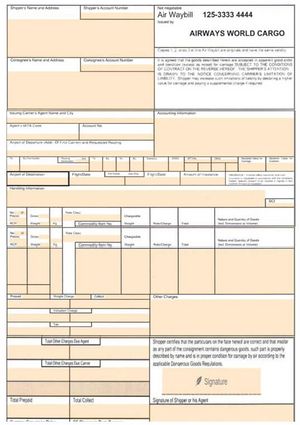Air Waybill (AWB) (Customs Glossary)
| This article is part of the Customs Glossary Guide |
In the context of North American trade, an Air Waybill (AWB) is a vital document used in air freight transportation to provide essential information about the shipment, including the origin, destination, and contents of the goods. An AWB serves as both a contract of carriage between the shipper and the airline and a receipt of goods for air cargo shipments. This article defines what an Air Waybill is in North American trade and explores the scenarios in which this document is utilized.

What is an Air Waybill (AWB)?
An Air Waybill is a crucial shipping document used for international and domestic air cargo transportation. It is issued by the airline or freight forwarder responsible for transporting the goods. The AWB acts as a contract of carriage, outlining the terms and conditions of transportation, and also serves as a receipt of the goods from the shipper. The document contains critical information about the shipment, such as the consignor and consignee details, flight information, handling instructions, and a description of the goods being transported.
Scenarios in Which an Air Waybill is Used:
International Air Freight:
Scenario: A company based in Canada wants to export its products to a customer in the United States. Usage of Air Waybill: The exporting company prepares an Air Waybill detailing the goods, their destination in the United States, and shipping instructions. The airline issues the AWB upon accepting the cargo, serving as proof of the contract for carriage and receipt of the goods.
Time-Sensitive Shipments:
Scenario: An electronics manufacturer needs to transport urgently needed electronic components to a factory in another country. Usage of Air Waybill: The manufacturer uses an Air Waybill to expedite the transportation process by providing comprehensive shipping instructions to the airline or freight forwarder. This ensures timely delivery of the time-sensitive goods.
Perishable Goods Transportation:
Scenario: A flower exporter in Mexico needs to ship fresh flowers to customers in Canada and the United States. Usage of Air Waybill: The exporter uses an Air Waybill to provide handling instructions and temperature-controlled requirements for the perishable cargo. This document ensures that the flowers reach their destinations in optimal condition.
Multimodal Transport:
Scenario: A company needs to transport goods from a factory in the United States to a distribution center in another country. Usage of Air Waybill: An Air Waybill is utilized for the air cargo segment of the journey, detailing the shipment's departure from the United States and arrival at the destination country's airport. This integrates seamlessly with other transportation modes, such as trucking or ocean freight.
Compliance and Customs Clearance:
Scenario: A company imports electronic devices from Asia to its warehouse in Canada for domestic distribution. Usage of Air Waybill: The Air Waybill serves as a crucial document for customs clearance, providing the necessary information to facilitate the goods' entry into Canada and compliance with customs regulations.
Conclusion:
An Air Waybill is a fundamental document in North American trade, facilitating air cargo transportation and providing essential information about the shipment. As a contract of carriage and receipt of goods, the Air Waybill streamlines logistics, ensures compliance, and plays a significant role in enabling the efficient movement of goods via air freight within the region and beyond.